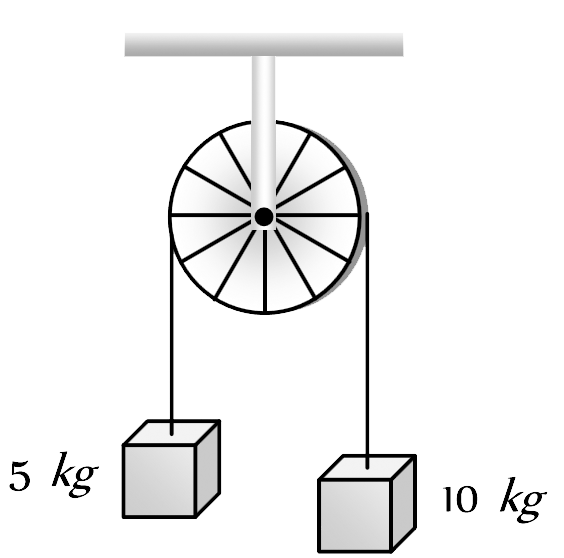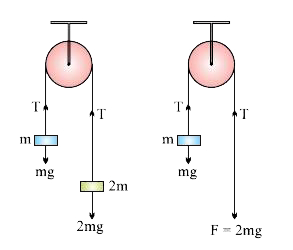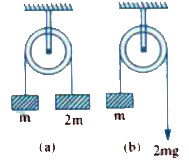The pulley arrangements shown in figure are identical, the mass of the rope being negligible. In case I the mass m is lifted by attaching a mass 2m to the other end of rope with a constant downward force F=2mg, where g is acceleration due to gravity The acceleration of mass m in case I is
 .Solution in Gujrati
.Solution in Gujrati
Zero
More than that in case (b)
Less than that in case (b)
Equal to that in case (b)
The correct Answer is:C
In case (b) entire tension =2mg, hence acceleration is more.
Topper's Solved these Questions
- NEWTONS LAWS OF MOTIONBOOK - ALLEN CHAPTER - NEWTONS LAWS OF MOTIONEXERCISE - EXERCISE-III
28 Videos
- NEWTONS LAWS OF MOTIONBOOK - ALLEN CHAPTER - NEWTONS LAWS OF MOTIONEXERCISE - EXERCISE-I
52 Videos
- NEWTON'S LAWS OF MOTION & FRICTIONBOOK - ALLEN CHAPTER - NEWTON'S LAWS OF MOTION & FRICTIONEXERCISE - EXERCISE (JA)
4 Videos
- RACEBOOK - ALLEN CHAPTER - RACEEXERCISE - Basic Maths (Wave Motion & Dopplers Effect) (Stationary waves & doppler effect, beats)
25 Videos
Similar Questions
Assertion: The driver in a vechicle moving with a constant speed on a straight road is in a non-inertial frame of referance.
Reason: A reference frame in which Newton's laws of motion are applicable is non-inertial.
View SolutionUSS 150) Two masses of 5 kg and 10 kg are connected to a pulley as shown. What will be the acceleration of the system (g= acceleration due to gravity)

View SolutionA piece of wire is bent in the shape of a parabola y=kx2 (y-axis vertical) with a bead of mass m on it. The bead can slide on the wire without friction. It stays at the lowest point of the parabola when the wire is at rest. The wire is now accelerated parallel to the x-axis with a constant acceleration a. The distance of the new equilibrium position of the bead, where the bead can stay at rest with respect to the wire, from the y-axis is:
View SolutionThe frequency of a radar is 780 MHz. After getting reflected from an approaching aeroplane, the apparent frequency is more than the actual frequency by 2.6 kHz. The aeroplane has a speed of
View SolutionThe pulley arrangements of Figs. (a) and (b) are identical. The mass of the rope is negligible. In (a) the mass m is lifted up by attaching a mass 2m to the other end of the rope. In (b), m is lifted up by pulling the other end of the rope with a constant downward force F=2mg. The acceleration of m is the same in both cases

View SolutionThe pulley arrangement in Fig are identical .The mass of the rope is negligble in figure the mass m is lifted up by atteched a mass 2m to the other end of the rope . In (b), m is lifed up by pulley the other end of the rope with a constant in both cases
View SolutionFigure shown two pulley arrangments for lifting a mass m . In case-1, the mass is lifting by attaching a mass 2m while in case-2 the mass is lifted by pulling the other end with a downward force F=2mg . If aa and ab are the accelerations of the two masses then (Assumme string is massless and pulley is ideal).

View SolutionThe pulley arrangements of fig (a) and (b) are identical. The mass of the rope is negligible. In (a) the mass m is lifted up by attaching a mass 2 m to the other end of the rope. In (b) m is lifted up by pulling the other end of the rope with a constant downward force F = 2 mg. Which of the following is correct?
View SolutionIn the arrangement shown, the mass m will ascend with an acceleration ( Pulley and rope are massless)
View SolutionThe pulley arrangement of fig. are identical. The mass of the rope is negligible. In (a) mass m is lifted up by attaching a mass (2 m) to the other end of the rope. In (b), m is lifted up by pulling the other end of the rope with a constant downward force F =2 mg. In which case, the acceleration of m is more ?

View SolutionThe pulley arrangements of figures (a) and (b) are identical. The mass of the rope is negligible. In figure (a), the mass m is lifted up by attaching a mass 2m to the other end of the rope. In figure(b), m is lifted up by pulling the other end of the rope with a constant downward force F = 2 mg. Calculate the accelerations in the two cases.

View SolutionThe pulley arrangements to Fig.(A) and (B), are identical. The mass of the rope is negligible. In (A) the mass mi s lifted up by attaching a mass 2m to the other end of the rope.
In (B) m is lifted up by pulling the other end of the rope with a constant downward force F=2mg. In which case the acceleration of 'm' is more?

View SolutionThe pulley arrangements of figures (a) and (b) are identical. The mass of the rope is negligible. In figure (a), the mass m is lifted up by attaching a mass 2m to the other end of the rope. In figure(b), m is lifted up by pulling the other end of the rope with a constant downward force F = 2 mg. Calculate the accelerations in the two cases.

View SolutionThe pulley arrangements to Fig.(A) and (B), are identical. The mass of the rope is negligible. In (A) the mass mi s lifted up by attaching a mass 2m to the other end of the rope. In (B) m is lifted up by pulling the other end of the rope with a constant downward force F=2mg. In which case the acceleration of 'm' is more?
View SolutionThe pulley arrangements of figures (I) and (II) are identical. The mass of the rope is negligible. In figure (I), the mass m is lifted up by attaching a mass 2m to the other end of the rope. In figure (II), m is lifted up by pulling the other end of the rope with a constant downward force F = 2 mg. Calculate the accelerations in the two cases.

View SolutionThe pulley arrangements of figures (a) and (b) are identical . The mass of the rope is negligible . In figure (a), the mass m is lifted up by attaching a mass 2m to the other end of the rope . In figure (b) , m is lifted up by pulling the other end of the rope with a constant downward force F=2mg . Calculate the accelerations in the two cases.
View Solution
